NGC Ancients: Mints of the Byzantine Empire
Posted on 3/8/2022
By
Ben Wallace
The Byzantine Empire existed for over a thousand years and controlled large tracts of land and a great many people. Many mints were needed to satisfy the monetary needs of this empire. In this article, we’ll discuss those mints and enjoy some of the coins they produced.
North Africa: Carthage
 |
The solidi of Carthage are known for their unique style and fabric. Many coins were made on thick and compact flans, as shown on the above gold solidus of Justinian II (A.D. 685-695). The obverse shows the emperor facing while the reverse features a cross potent on three steps.
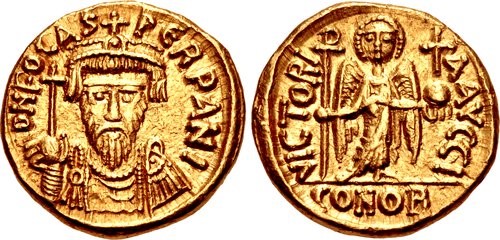 |
The flan of the solidus of the emperor Phocas (A.D. 602-610) shown above isn’t as compact as that of the previous coin, but the style still marks it as being from Carthage. The emperor is shown facing and holding a globus cruciger. An angel on the reverse is shown holding its own globus cruciger and a large cross.
Sicily: Catania
 |
The 14mm copper decanummium shown above portrays the emperor Maurice Tiberius (A.D. 582-602). The reverse has a large I for the denomination and the mintmark CAT in the exergue.
 |
The emperor Heraclius (A.D. 610-641) is featured on the decanummium above, also from Catania.
Sicily: Syracuse
 |
The above follis features an excellent portrait of the emperor Constans II (A.D. 641-688). Much of the detail on this coin is weak due to it being overstruck on an earlier follis. The reverse has a large M and the mintmark SCL below.
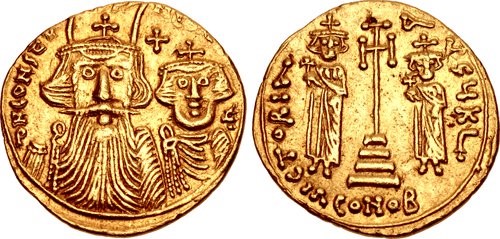 |
The solidus above also features Constans II, this time with his son, Constantine IV. The reverse shows the emperor’s other two sons, Heraclius and Tiberius, standing with a cross potent between them.
Italy: Naples
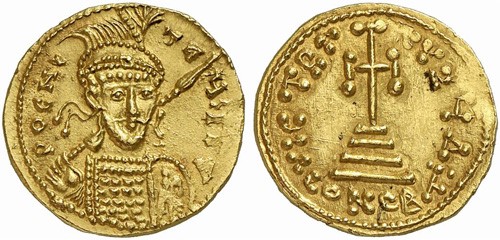 |
Made during the rule of Constantine IV (A.D. 668-685), the emperor is shown in military
attire holding a spear and shield. On the reverse is a cross potent on three steps.
Italy: Rome
 |
This rare solidus was produced in the former capital of the Roman Empire. Made during the rule of the emperor Justinian I (A.D. 527-565), the above coin is of a distinctive engraving style. The emperor is shown facing on the obverse and an angel appears on the reverse.
Italy: Ravenna
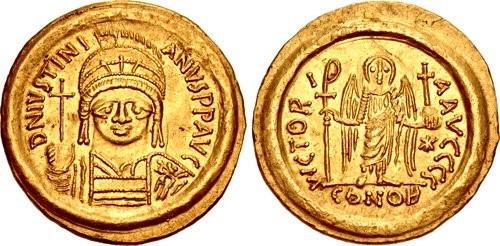 |
The northern Italian city of Ravenna was recaptured from the Ostrogoths during the reign of Justinian I, who then began to strike coins there. The above solidus features the emperor’s facing bust, holding a globulus cruciger. A facing angel is shown on the reverse holding a long cross and a globulus cruciger.
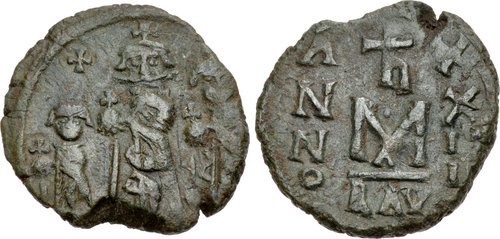 |
Made under the emperor Heraclius, the above copper follis shows the emperor standing with his two sons. The mintmark RAV can be seen beneath the denomination marker.
Crimea: Cherson
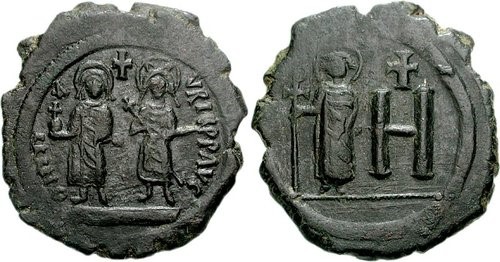 |
While there is no mintmark on this coin, it is believed to be from the Cherson mint. The obverse shows the emperor Maurice Tiberius standing with his wife Constantia. The reverse shows the son of Maurice, Theodosius, standing next to the denomination mark H (which equates'8').
Greece: Salona
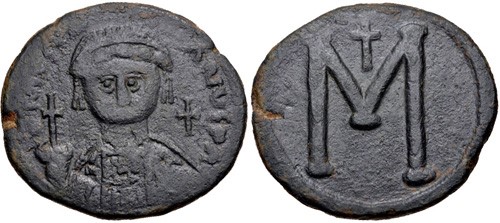 |
The attribution of this coin is uncertain, but many examples have been found in the area around Salona. Located on the Dalmatian coast of Greece, this was an important fort and staging area for military activities in Italy. A primitive bust of the emperor Justinian I is shown facing. The reverse has a large M and a cross.
Greece: Arta
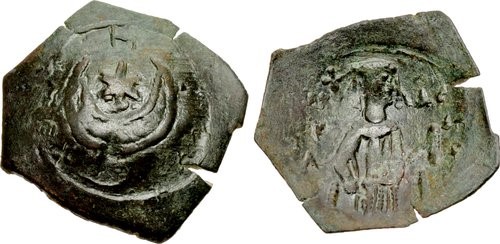 |
The despot Michael II Angelus (A.D. 1237-1272), a relative of the emperor Alexius III (A.D. 1195-1203), made his capital in the city of Arta. The bronze trachy above is very crude. The obverse shows a star above a crescent and the reverse shows the arch-angel Michael.
Greece: Thessalonica
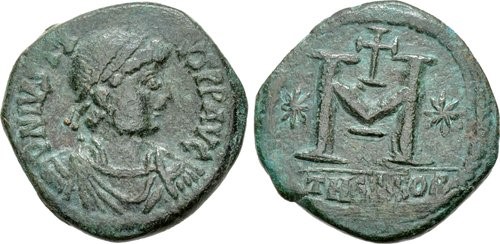 |
Made during the rule of Justin I (A.D. 518-527), the above follis is interesting because of its mintmark THESSOB, which is much longer than the typical ΘES and TES used at this mint.
Thrace: Philippopolis
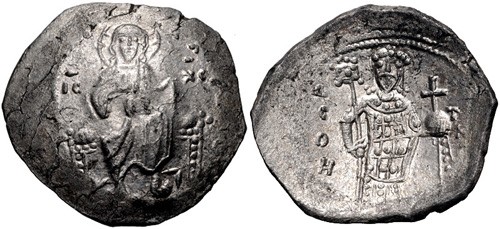 |
While the identity of this mint isn’t fully verified, the above coin is believed to have been made at Philippopolis. Minted during the reign of Alexius I Comnenus (A.D. 1080-1118), the obverse shows an enthroned Christ. On the reverse the emperor holds a labarum and globulus cruciger.
Turkey: Constantinople
This city was dedicated by Constantine I “the Great” (A.D. 306-337) in A.D. 330 and became the capital of both the Roman and Byzantine Empires. Its mint was one of the most active throughout the course of the empire.
 |
The large 44mm follis above was made for the emperor Justinian I. He is shown holding a globus cruciger and shield. On the reverse is the mintmark CON.
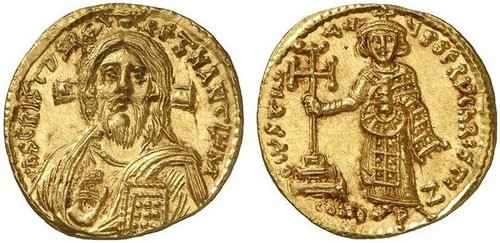 |
The gold solidus above was made during the first reign of the emperor Justinian II (A.D. 692-695). The obverse shows a bust of Christ giving a benediction. The reverse has the emperor holding a long cross and the mintmark CONOP in the exergue. This is the first time an image of Christ appeared on a Byzantine coin.
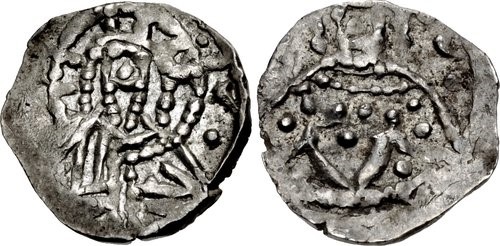 |
Perhaps one of the last coins made for the Byzantine empire before its final destruction, this 1/8th stravraton is from the reign of the emperor Constantine XI (A.D. 1448-1458). Crude in execution and appearance, this coin features a nimbate bust of Christ and the crowned bust of the emperor.
Turkey: Nicomedia
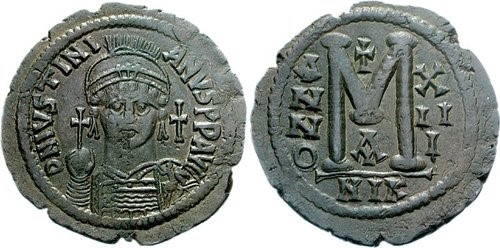 |
The large follis above was made for Justinian I and shows his facing portrait. It was made in the 13th year (A.D. 539/40) of his rule. The reverse has a large M and a cross, with the mintmark NIK below.
Turkey: Cyzicus
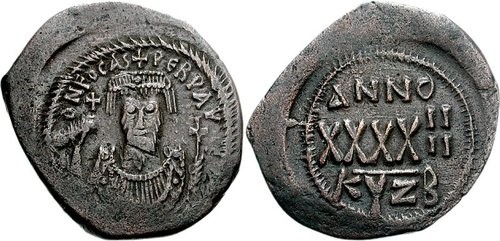 |
Minted in the 4th year (A.D. 605/6) of the reign of Phocas, this coin shows the facing bust of the ruler. The reverse marks the denomination as XXXX (‘40’) and has the mintmark KYZB.
Turkey: Magnesia
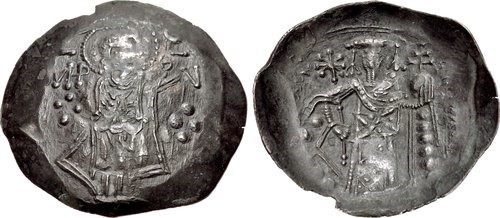 |
Made during the reign of John III Ducas (A.D. 1222-1254) the above trachy shows the Virgin Mary. The emperor is also shown holding a star-tipped scepter and globulus cruciger.
Turkey: Isaura
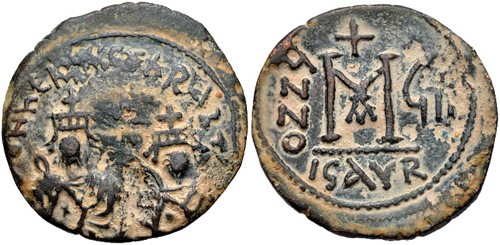 |
The above coin is of a very crude style, showing the bust of the emperor Heraclius and his son, Heraclius Constantine. It was made in the 8th year (A.D. 617/8) of his rule. The reverse has the mintmark ISAVR in the exergue.
Turkey: Seleucia Isauria
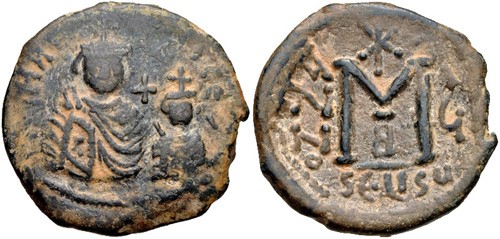 |
Made during the 7th year (A.D. 616/7) of the emperor Heraclius’ rule, this coin also shows the emperor and his son Heraclius Constantine. On the reverse is a large M with a Christogram above, and the mintmark SELISU below.
Syria: Alexandretta
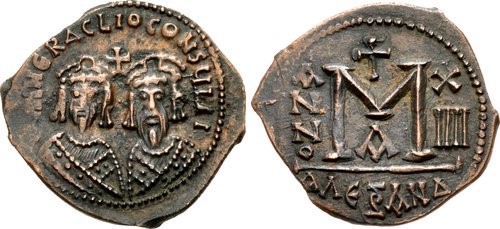 |
This mint was active during the revolt of the Heraclii against the emperor Phocas in A.D. 608-610. The above follis features the future emperor Heraclius along with his father, who also was named Heraclius. The mintmark ALEXAND can be seen in the exergue of this rare coin.
Syria: Antioch
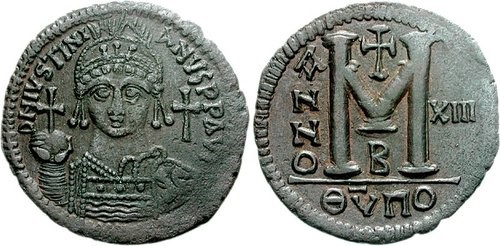 |
On this follis, the emperor Justinian I is shown facing, holding a globus cruciger and a shield. The reverse features a large M over the mintmark ΘVΠO.
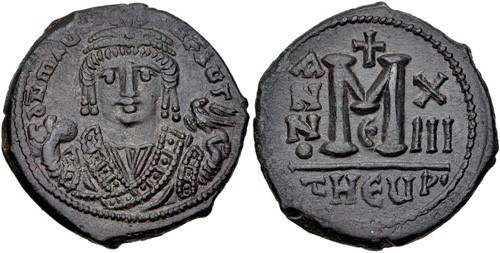 |
Minted during the reign of the emperor Maurice Tiberius, this follis also shows the ruler facing, but this time he wears consular robes and holds a mappa and eagle-tipped scepter. A large M denotes the denomination with the 13th regnal year (A.D. 594/5) marked to the right. The mintmark THEUP is in the exergue.
Cyprus: Nicosia
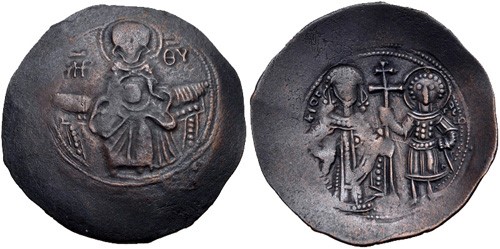 |
Isaac Comnenus (A.D. 1185-1191) was the son of a former Byzantine emperor. He became disgruntled by the empire and made his own kingdom by taking over the island of Cyprus. He ruled cruelly and was eventually overthrown by the famous English king, Richard the Lionheart. The billion aspron trachy above was made in Nicosia, on Cyprus, and shows the Virgin Mary holding an infant Christ in her lap. The reverse shows Isaac and Saint George holding a long cross.
Cyprus: Constantia
 |
While this coin was possibly made at Constantia, its attribution isn’t certain. The emperor Heraclius is shown with his wife and son on this follis. The reverse features the denomination and the mintmark KVΠP.
Judaea: Jerusalem
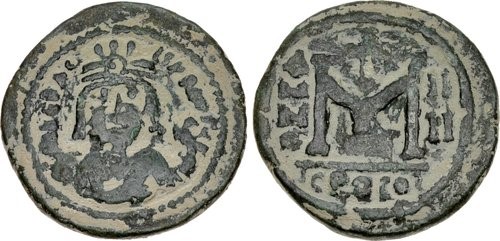 |
This rare piece is one of the few coins with a mintmark indicative of the city of Jerusalem. Possibly made during the Persian siege of A.D. 614, this coin is very rough and simple in appearance. While it was made during the rule of Heraclius, the royal portrait harkens back to the earlier styles of Phocas and Maurice Tiberius. The mintmark is IEPOCOS.
Egypt: Alexandria
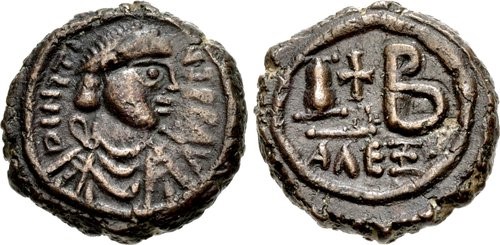 |
Among the earliest Byzantine coins struck at Alexandria is this copper 12-nummi featuring the emperor Justin I. On the reverse, IB (‘12’) marks the denomination and ALEΞ indicates the mint.
All photos courtesy of Classical Numismatic Group.
Interested in reading more articles on Ancient coins? Click here.
Stay Informed
Want news like this delivered to your inbox once a month? Subscribe to the free NGC eNewsletter today!
